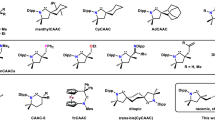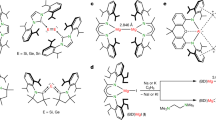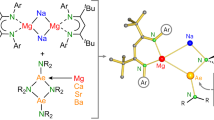Abstract
THE complexing properties of 2-pyridinaldoxime (I) would be expected to follow from those of 2,2′-bipyridine (II) and dimethylglyoxime (III) since this new ligand incorporates in its structure the functional groups of both the latter substances. In the course of synthesizing and characterizing the nickel(II) complexes of pyridinaldoxime (HPAO) it has become apparent that some very unusual deviations from the expected behaviour occur. By analogy with the nickel(II) complexes of 2,2′-bipyridine1, two complexes containing molecular pyridinaldoxime should form: bis(pyridinaldoxime)nickel(II) and tris-(pyridinaldoxime)nickel(II). In addition, a third complex, containing one molecule of pyridinaldoxime co-ordinated to each nickel(II) atom, might also be expected to exist. The first two complexes, [Ni(HPA0)2]++ and [Ni(HPA0)3]++, have been prepared as the chloride and iodide salts, respectively. The bis complex is prepared by mixing 1 mole of nickel chloride 6-hydrate with 2 moles of the ligand in hot absolute ethanol. The compound is precipitated as fine green crystals. The tris complex may be isolated as fine tan crystals by mixing 3 moles of ligand with 1 mole of nickel(II) chloride in aqueous solution, followed by the addition of solid potassium iodide. The colour changes occurring in aqueous solutions indicate that the bis-pyridinaldoxime complex is considerably less subject to disproportionate, and consequent formation of the tris complex, than is true of the corresponding 2,2′-bipyridine complex. Both the bis and tris complexes containing the neutral pyridinaldoxime molecule are paramagnetic, having corrected effective magnetic moments of 3.16 and 3.12 Bohr magnetons, respectively. It may be concluded that these compounds are normal representatives of the classes of nickel(II) complexes formed by the aromatic heterocyclic diamines and other related ligands.
This is a preview of subscription content, access via your institution
Access options
Subscribe to this journal
Receive 51 print issues and online access
$199.00 per year
only $3.90 per issue
Buy this article
- Purchase on Springer Link
- Instant access to full article PDF
Prices may be subject to local taxes which are calculated during checkout
Similar content being viewed by others
References
Brandt, W. W., Dwyer, F. P., and Gyarfas, E. C., Chem. Rev., 54, 959 (1954).
Murmann, R. K., J. Amer. Chem. Soc., 79, 521 (1957).
Author information
Authors and Affiliations
Rights and permissions
About this article
Cite this article
KRAUSE, R., BUSCH, D. Complexes of Nickel(II) with 2-Pyridinaldoxime. Nature 181, 1529–1530 (1958). https://doi.org/10.1038/1811529b0
Issue Date:
DOI: https://doi.org/10.1038/1811529b0
This article is cited by
-
Pyridine-2-aldoxime complexes of rare earths
Chemistry of Heterocyclic Compounds (1968)
-
Ferrous and Ferric Complexes with Pyridine 2-Aldoxime
Nature (1959)
Comments
By submitting a comment you agree to abide by our Terms and Community Guidelines. If you find something abusive or that does not comply with our terms or guidelines please flag it as inappropriate.



